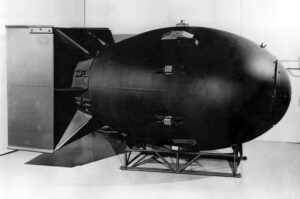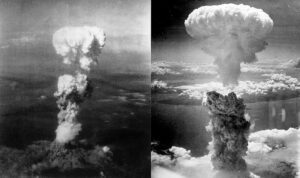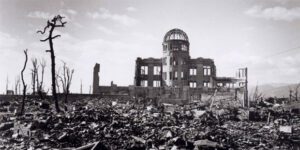At 8.15am on the morning of 6th August 1945, the Japanese city of Hiroshima was destroyed by the first atomic bomb to be used as a weapon of war.
First Attack
The bomb named ‘Little Boy’ was dropped from the USAFF B29 bomber ‘Enola Gay’ and was exploded at around 18,000 feet above the city. Delivering the equivalent of around 12.5 Kilotons of TNT, the bomb reduced 5 square miles of the city centre to ashes and caused the deaths of an estimated 120,000 people within the first four days following the blast. Many were instantly vaporised by the explosion, others died afterwards from the effects of burns and radiation.

Second Attack
Three days later, just after 11am on the morning of 9th August, a second atomic bomb nicknamed ‘Fat Man’ exploded above the city of Nagasaki. Although it was even more powerful than ‘Little Boy’, the destruction caused by this bomb was less than Hiroshima due to the nature of the terrain, (the original target had been the city of Kohura, but the B29 carrying the bomb had been diverted to Nagasaki because of heavy cloud cover). Furthermore, two square miles of the city were pulverised and 73,000 people killed.

Two atomic explosions had the effects desired by the Allies.
On 10th August the Japanese government indicated its readiness to accept defeat subject to certain conditions. On 14th August the country finally accepted the demand for unconditional surrender. The following day was declared ‘Victory over Japan’ known to many as VJ Day. Although it was not until 2nd September that the surrender was signed, thereby bringing the Second World War to a formal end.

Why such destruction?
Why had the Allied powers considered it necessary to inflict such unprecedented destruction on Japanese civilians? At the Potsdam Conference (17th July – 2nd August 1945) the Allies formulated their terms for ending the war with Japan, which centred on that country’s acceptance of unconditional surrender, as had been the case with Nazi Germany n May. However, the allies were also aware that whilst the Japanese Emperor Hirohito desired an end to hostilities, and would probably accept the unconditional capitulation demanded, the ‘hawks’ of the Japanese military and civilian leadership were totally opposed to such a humiliating condition and were ready to fight to the finish – whatever that might look like.

Potsdam
This knowledge informed the contents of the Potsdam Declaration, in particular the statement that failure to accept unconditional surrender would result in ‘prompt and utter destruction’ for Japan. It was no coincidence that on 16th July, the day before the opening of the Potsdam Conference, the world’s first nuclear bomb was detonated in the desert of New Mexico, demonstrating the largest destructive power ever seen in a man-made device. In one split second, the face of war changed completely.
Bibliography:
-IWM, Accessed 30/07/2022, for the use of Forgotten Friday.


